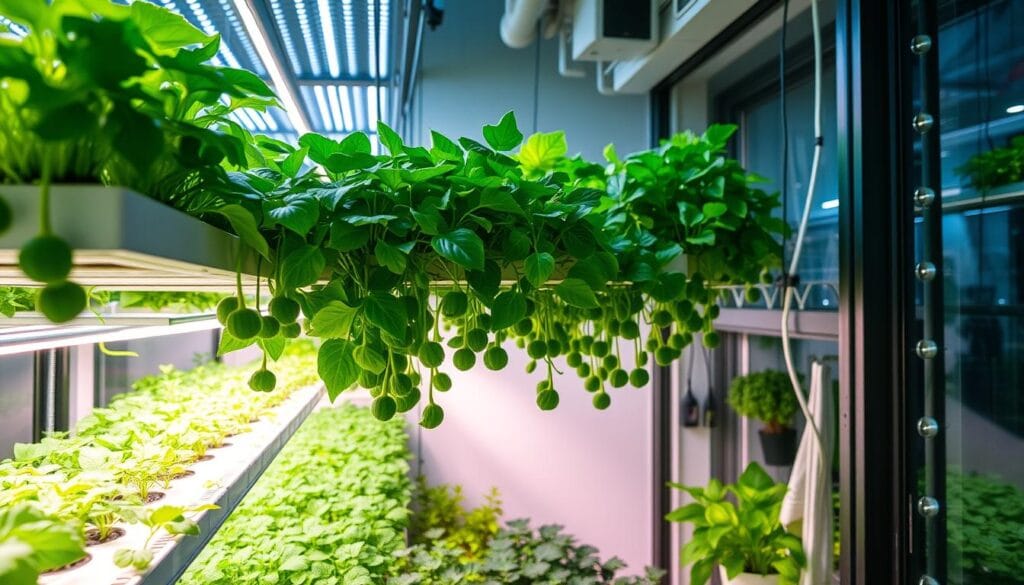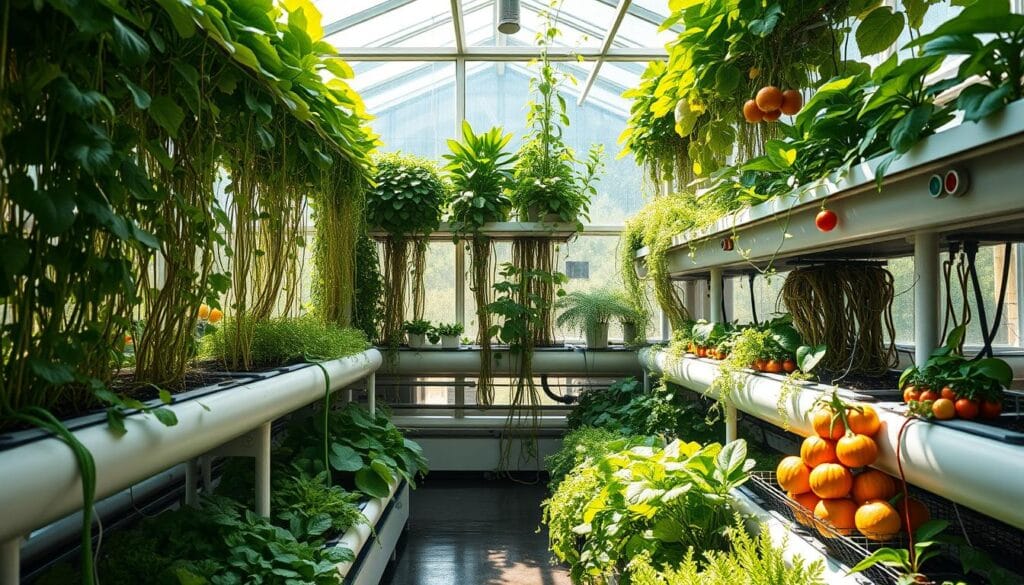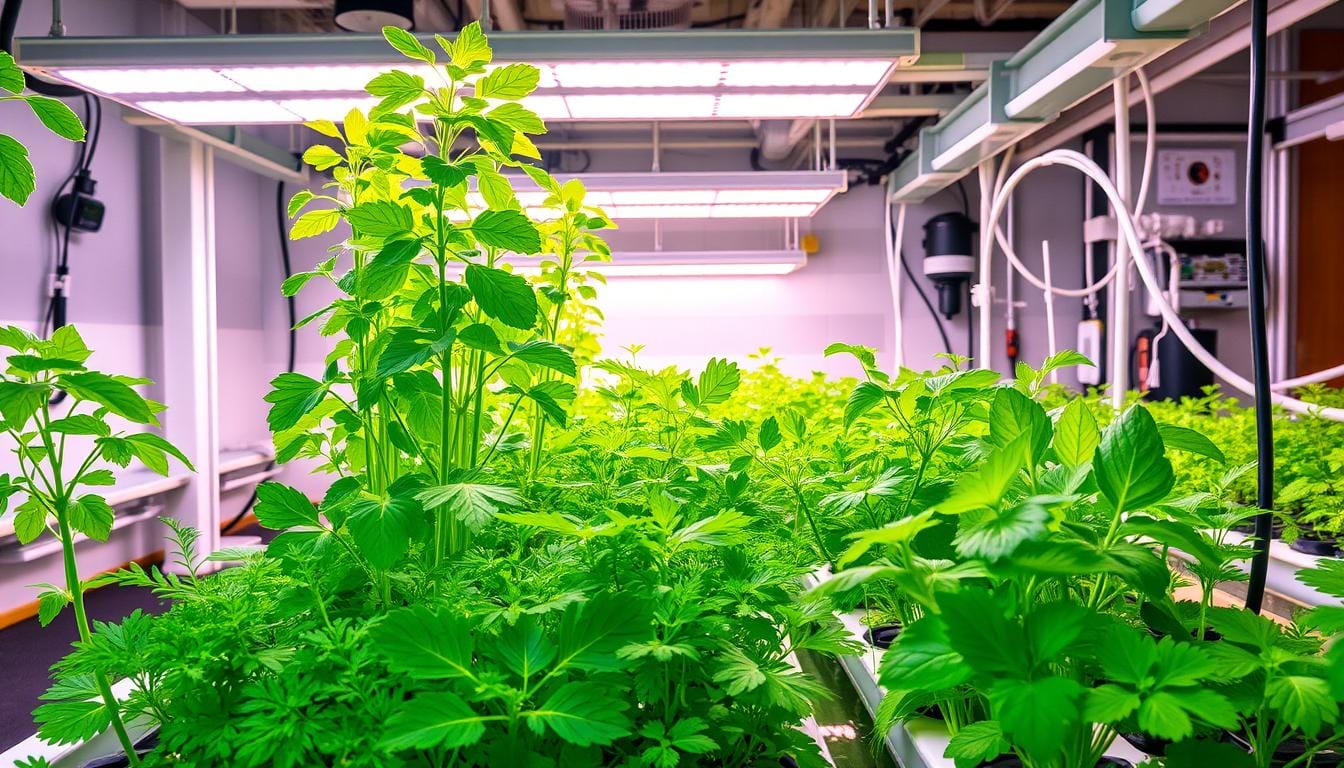Hydroponics pros are evident the moment you step into a hydroponic garden. When I visited my friend’s setup, I was amazed by the colors and greenery. The plants looked healthy and strong, unlike those grown in soil. This made me see the power of hydroponics, a new way to grow food.
Hydroponics is becoming more popular in farming. The market was worth $5.00 billion in 2023 and is growing fast. This method has many benefits that are changing farming for the better. Let’s look at 10 great reasons why hydroponics is amazing.
Key Takeaways
- Hydroponics can accelerate plant growth, achieving up to twice the rate of traditional farming methods.
- Plants grown hydroponically can achieve up to 16 times the density of those cultivated in soil.
- Hydroponic farms use up to 90% less water than traditional farms.
- Hydroponics only uses up to 50% of the nutrients used compared to conventional agricultural methods.
- Hydroponic farming can yield up to 18 harvests per year, significantly more than the average 3 harvests from soil farming.
Understanding Modern Hydroponic Cultivation
Hydroponic systems are changing how we grow crops. They use water-based solutions instead of soil. This method offers big advantages, making farming better.
Defining Soilless Growing Systems
Hydroponic systems give plants all they need through water. This way, plants grow well without soil. It also saves water and lets farmers control the growing space better.
Basic Components of Hydroponic Systems
- Nutrient tanks: Solutions with minerals and nutrients for plant growth
- Lighting systems: LED lights provide the optimal light spectrum for plant growth.
- Temperature and climate control: Systems to keep the perfect growing conditions
- Plumbing and water delivery: Pipes and pumps for the nutrient solution
Evolution of Water-Based Farming
Hydroponics have evolved a lot. Now, they are more efficient and precise. Modern setups help plants grow fast and well.
| Metric | Hydroponic Farming | Traditional Soil-Based Farming |
|---|---|---|
| Water Usage | Up to 90% less water | Significantly higher water consumption |
| Growth Rate | 25-30% faster growth | Slower growth rates |
| Yield | Higher crop yields | Lower and more variable yields |
| Nutrient Efficiency | Precise nutrient delivery | Reliance on soil nutrient cycling |
| Pest and Disease Control | Reduced need for pesticides | Greater susceptibility to pests and diseases |
Hydroponics have changed farming for the better. They make growing crops sustainable and efficient. This is a big step forward in modern agriculture.
Hydroponics Pros: A Game-Changer in Agriculture
Hydroponic gardening and soilless farming are changing agriculture. They offer many benefits that are making farming better. These new methods solve old problems and lead to a greener, more efficient future.
One big plus of hydroponics is how fast plants grow. Hydroponic systems enable plants to grow 30-50% faster than traditional soil-based methods. This means quicker harvests and more food.
Hydroponics also saves a lot of water. They use up to 90% less water than regular farming. This is because they use a closed system that doesn’t lose water to evaporation or runoff.
Another great thing about hydroponics is how it makes the most of small spaces. It can grow more food in tight spots, like cities or small farms. This is perfect for places where space is limited.
Hydroponics also lets farmers grow food all year. This is different from regular farming, which is limited by seasons. It means people always have access to fresh, healthy food.
Finally, hydroponics needs fewer chemicals. Since it doesn’t use soil, it’s less likely to get diseases or pests. This makes growing food healthier and more eco-friendly.
| Hydroponic Gardening Benefits | Soilless Farming Merits |
|---|---|
|
|
Hydroponic gardening and soilless farming are changing agriculture for the better. They solve old problems and lead to a greener, more efficient future.
“Hydroponic systems are designed to minimize environmental impact, reducing the risk of nutrient runoff, erosion, and the need for chemical treatments.”
Maximizing Crop Yields Through Controlled Growth
Hydroponic systems are changing the game in farming. They offer new ways to grow crops efficiently. This technology is breaking the limits of old farming methods.
Growth Rate Comparison with Traditional Farming
Hydroponics speeds up plant growth like never before. It’s significantly quicker than growing plants in soil. This is because hydroponics controls nutrients and growing conditions perfectly.
Plant Density Optimization
Hydroponics lets you grow more plants in less space. You can grow up to 16 times more plants per square foot than in soil. This means more food from the same area.
Year-Round Growing Capabilities
Hydroponics can grow crops all year, no matter the weather. This means fresh food is always available. It’s great for meeting the growing need for food.
Hydroponic systems are changing farming for the better. They help grow more food, use space better, and grow crops all year. As we need more food, these systems will be key in the future of farming.
Revolutionary Water Conservation Benefits
Hydroponic farming is changing the game in sustainable agriculture. It requires up to 90% less water compared to conventional farming. This shows how efficient and eco-friendly hydroponics are.
Hydroponics saves water by recycling it. Unlike old farming, where water gets lost, hydroponics keep it in a loop. This cuts down water use and environmental harm.
Hydroponics also uses water wisely. They deliver nutrients precisely, wasting little water. This makes food production more sustainable.
| Water Conservation Techniques | Sustainable Food Production Methods |
|---|---|
|
|
As water scarcity grows, hydroponics offers a solution. It’s a game-changer for water and food. Hydroponics are key to a greener, more sustainable future.
Enhanced Nutrient Management and Efficiency
Hydroponic cultivation is changing modern agriculture. It offers a sustainable and efficient way to grow crops. One big advantage is how it manages nutrients, leading to better productivity and resource use.
Direct Nutrient Delivery Systems
In traditional farming, plants often miss out on nutrients. Hydroponics, however, gives nutrients directly to the roots through water. This ensures plants get exactly what they need, leading to faster growth and higher yields.
Resource Recycling Advantages
Hydroponics is great at recycling resources. It can save up to 90% of water compared to traditional farming. It also allows for precise nutrient management, reducing waste and environmental impact.
Precision Feeding Methods
Hydroponics uses advanced methods to feed plants exactly what they need. This control over nutrients boosts crop yields and makes farming more efficient and sustainable. Growers can optimize crop potential while reducing waste and environmental strain.
Hydroponics is key to a new era of efficient crop cultivation and sustainable food production methods. As food demand grows, these innovative farming methods offer a promising solution for global food security.
| Nutrient Management Metric | Traditional Farming | Hydroponic Cultivation |
|---|---|---|
| Water Consumption | High | Up to 90% less |
| Nutrient Utilization | Inefficient, with significant waste | Precise delivery, minimal waste |
| Crop Yield | Moderate | Up to 16 times greater |
| Pesticide Dependency | High | Significantly reduced |
Climate-Controlled Environment Advantages
Hydroponic systems create a controlled environment that shields plants from harsh weather. They control temperature, humidity, and lighting precisely. This allows for growing a wide variety of plants anywhere, all year round.
For example, lettuce grows best in temperatures between 18°C to 24°C (64°F to 75°F). Tomatoes need warmer temperatures, around 21°C to 27°C (70°F to 80°F). Hydroponics keeps these conditions perfect, making it easy to grow these crops indoors.
Hydroponics also manage humidity and CO2 levels. Keeping humidity between 60-80% prevents diseases and promotes healthy growth. Boosting CO2 levels to 1000-1500 ppm increases photosynthesis and plant growth.
| Environmental Factor | Optimal Range for Hydroponics |
|---|---|
| Temperature | 18°C to 27°C (64°F to 80°F) |
| Light Intensity | 200 to 1000 μmol/m²/s |
| CO2 Concentration | 1000 to 1500 ppm |
| Relative Humidity | 60% to 80% |
Hydroponics carefully controls these factors, giving plants the best conditions for growth. This leads to higher yields, better quality, and longer growing seasons. It’s a big step forward in controlled environment agriculture and brings many indoor gardening advantages for both big and small growers.

Space Optimization and Urban Farming Solutions
Urban farming is changing how we grow and get fresh food. Hydroponic systems lead this change. They use less space, perfect for urban farming and indoor gardening advantages.
Vertical Growing Possibilities
Hydroponic systems grow crops vertically, saving space. Traditional farming needs lots of land. But hydroponics stack up, fitting more plants in less space.
This vertical method is great for urban farming solutions. It uses rooftops and old warehouses well.
Compact Design Benefits
Hydroponic systems are built to be small and efficient. They don’t need big roots like soil farming. This lets them pack more plants in a small area.
This design saves space and is good for indoor gardening advantages. It works well in homes, restaurants, or offices.
Small-Scale Implementation
Hydroponic systems work for any size of farming. They’re perfect for small spaces. People, groups, and businesses can start small.
From small setups to big systems, hydroponics lets anyone grow food indoors. It turns any space into a productive garden.
Hydroponics help urban areas grow food and be more green. It makes food fresh and available. It also brings people together and makes cities better.
Sustainable Agricultural Practices
Hydroponic farming is revolutionizing sustainable agriculture. It uses efficient crop cultivation methods and cuts down on resource use. This makes hydroponics a key player in sustainable food production worldwide.
Hydroponics can make crops grow up to 50% faster than traditional farming. This is thanks to precise nutrient delivery and controlled growing conditions. These conditions help plants grow and develop better.
Hydroponic systems use only 10% of the water needed in regular farming. This shows how water-efficient these methods are. Techniques like Nutrient Film Technique (NFT), Deep Water Culture (DWC), and Aeroponics also help save water. They recycle and use water solutions efficiently.
Hydroponic farming also cuts down on the use of pesticides and herbicides. A controlled environment means less risk of land and soil damage. This makes hydroponics a green choice for farming.
“Hydroponics can result in remarkable growth speeds, often accelerating plant growth by up to 50% compared to traditional farming methods.”
The world is facing challenges like land loss and the need for sustainable food. Hydroponic systems offer a solution. They use space well and allow for year-round farming. This makes food systems more secure and reliable.
In summary, hydroponic agriculture is a game-changer for a greener, more efficient food future. As the industry grows, using these innovative methods will be key. It will help meet the demand for sustainable, high-quality food.

Economic Benefits and Market Growth Potential
The hydroponics industry is booming, with a 12.4% growth rate expected from 2024 to 2030. Starting a hydroponic farm can cost a lot, but it can also bring in more money. This method uses less water, manages nutrients better, and controls the climate, making it a big deal in farming.
Industry Growth Statistics
More people want food that’s good for the planet and grown locally. Hydroponics use up to 98% less water than old-school farms. They also grow crops faster and more efficiently, leading to more money made quickly.
Return on Investment Analysis
Starting a hydroponic farm can cost from $500 to over $100,000. But, it can also make a lot of money because of the high demand for fresh produce. Plus, it saves water and land, which is good for the planet and your wallet.
Market Expansion Opportunities
The hydroponics market is growing fast, especially in cities. Urban farms cut down on shipping costs and make food fresher. They can also sell more by making value-added products and offering tours.
| Metric | Value |
|---|---|
| Projected Market Growth Rate (2024-2030) | 12.4% CAGR |
| Water Usage Reduction Compared to Traditional Farming | Up to 98% |
| Crop Growth Rate Increase Compared to Traditional Farming | Up to 25% |
| Initial Setup Costs (Small-Scale to Commercial) | $500 to $100,000+ |
| Annual Nutrient Solution Costs | Up to $1,000 |
| Annual Electricity Costs (Medium-Sized Operations) | Up to $5,000 |
Hydroponic farming often requires a higher initial investment compared to traditional soil-based farming, but the potential for premium pricing and reduced operational expenses can make it a lucrative investment.
Conclusion: The Future of Hydroponic Agriculture
Hydroponic agriculture is a bright spot for sustainable food production. It’s efficient with resources, produces more food, and is good for the environment. This makes it key for solving global food security issues.
Hydroponics allows for growing crops vertically and all year, using less water and no harmful chemicals. This is a big change in farming. It lets people grow many types of crops, from greens to fruits, in a way that’s good for the planet.
Hydroponic tech is getting better, making it easier for everyone to use. This includes simple kits and better control over nutrients. With more people using hydroponics, and the chance for good profits, its future looks very promising.

